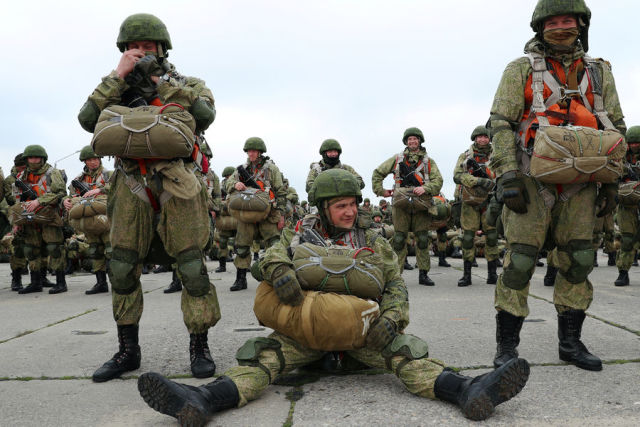Colonel Khodarenok explained what reforms the Airborne Troops need
The American edition of Military Watch Magazine published an article about the Russian amphibious forces, where it called the approach to their formation "outdated". Military observer of the Newspaper.En" Mikhail Khodarenok dealt with this statement.
"Russian Airborne troops are formed and armed according to outdated principles that are characteristic of the middle of the XX century. They are preparing for large-scale amphibious operations that have not been carried out for a long time," says Military Watch Magazine.
Indeed, the Russian airborne forces in all armed conflicts of the last ten years were used not as a landing force, but as well-trained infantry. There were two exceptions.
On August 21, 1968, during Operation Danube, in order to capture the capital of Czechoslovakia, Prague, units and units of two airborne divisions were landed at once - the 7th and 103rd.
In December 1979, an airborne operation was carried out to deliver parts of the 103rd Airborne Division from Vitebsk and the 345th separate parachute Regiment from Ferghana to the Afghan airfields of Bagram and Kabul. It was also carried out by landing method. It should be noted - and this is significant - that in 1968 and in 1979 there was no resistance to the landing of troops.
It is particularly worth emphasizing once again that during these operations, the landing was carried out precisely by landing, and not by parachute. The latter has not been massively used at all since the Great Patriotic War.
Despite the minimal experience of actual amphibious operations, the Airborne Forces, according to tradition, are equipped with "special" mobile equipment.
Since the equipment being developed and manufactured to equip the airborne forces is designed to be parachuted out of Il-76 aircraft, it has a light bulletproof reservation, is made of aluminum alloys and has significantly lower protection compared to the equipment used by the ground forces. This naturally worsens her fighting qualities.
Another systemic problem concerns military transport aviation.
The fact is that the main domestic IL-76 transport vehicle was "sharpened" precisely for the needs of amphibious troops. As a result, the dimensions of its cargo cabin simply do not allow transporting equipment except for airborne weapons. Everything else just doesn't come in without a complete disassembly. For example, helicopters need to be disassembled, planes too. Anti-aircraft missile systems in size in the IL-76 also do not pass.
At the same time, the IL-76 can carry almost anything in terms of its carrying capacity. Theoretically, it can lift 80% of domestic military equipment, but it cannot be placed on an airplane.
It is significant at the same time that over the past half century, even one battalion has never been parachuted out of the Il-76 during combat operations.
Airborne troops are currently called the reserve of the Supreme Commander-in-Chief, but in order for them to really meet this requirement, it is necessary to radically change the organizational and staff structure of the airborne forces and equip these troops with heavy equipment - the landing needs more armor for the effective implementation of assault operations.
It is advisable to preserve the total staffing of the Airborne Forces, leave all existing names (including honorary ones), banners, uniforms and blue berets to the troops.
The organizational and staff structure and armament of the amphibious assault (airborne) division should probably look like this. Instead of BMDS with their aluminum armor, the parachute regiments should have T-15 heavy infantry fighting vehicles based on the promising T-14 Armata tank. The tank regiment should receive the T-14, and the self-propelled artillery - 2S35 "Coalition-SV" guns.
The Airborne division should be equipped with the necessary number of unmanned aerial vehicles for various purposes - from light to heavy shock.
In such formations, it is advisable to move away from such regular units as a parachute company and switch to combat tactical modules.
Such a unit will have a higher potential compared to regular motorized rifle units, and most importantly, it will have equally effective mobility and security. In short, the main indicator of the success of airborne units on the battlefield today is improved armor protection.
The opinion of the author may not coincide with the position of the editorial board.
Biography of the author:
Mikhail Mikhailovich Khodarenok is a military columnist for the newspaper.Ru", retired colonel.
He graduated from the Minsk Higher Engineering Anti-Aircraft Missile School (1976), the Military Air Defense Command Academy (1986).
Commander of the S-75 anti-aircraft missile division (1980-1983).
Deputy Commander of the anti-aircraft missile regiment (1986-1988).
Senior Officer of the General Staff of the Air Defense Forces (1988-1992).
Officer of the Main Operational Directorate of the General Staff (1992-2000).
Graduated from the Military Academy of the General Staff of the Armed Forces of Russia (1998).
Columnist of "Nezavisimaya Gazeta" (2000-2003), editor-in-chief of the newspaper "Military-Industrial Courier" (2010-2015).
Mikhail Khodarenok

